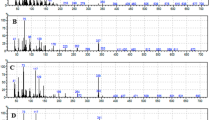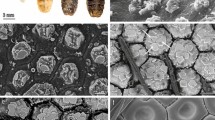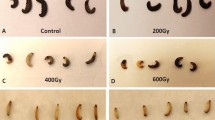Abstract
DURING an examination of the amino-acid composition of the larval cuticle of the blow-fly, Calliphora vomitoria, it was found that phenylalanine and tyrosine were readily removed by extraction with water at 50° C. for 2 hr. Surprisingly, however, these amino-acids could not be recognized in the extract. Instead, alanine and ninhydrin-negative diphenolic compounds were found. This observation suggested that the cuticle is capable of hydroxylating aromatic amino-acids in a manner similar to the action of the artificial system studied by Dalgliesh1.
This is a preview of subscription content, access via your institution
Access options
Subscribe to this journal
Receive 51 print issues and online access
$199.00 per year
only $3.90 per issue
Buy this article
- Purchase on Springer Link
- Instant access to full article PDF
Prices may be subject to local taxes which are calculated during checkout
Similar content being viewed by others
References
Dalgliesh, C. E., Arch. Biochem. Biophys., 58, 214 (1955).
Author information
Authors and Affiliations
Rights and permissions
About this article
Cite this article
DENNELL, R. Non-specific Hydroxylation of Aromatic Amino-Acids by an Insect Cuticle. Nature 180, 1070–1071 (1957). https://doi.org/10.1038/1801070a0
Issue Date:
DOI: https://doi.org/10.1038/1801070a0
This article is cited by
Comments
By submitting a comment you agree to abide by our Terms and Community Guidelines. If you find something abusive or that does not comply with our terms or guidelines please flag it as inappropriate.



